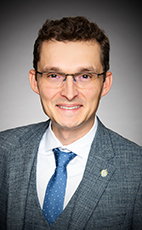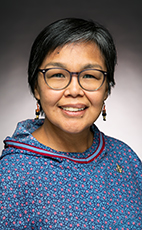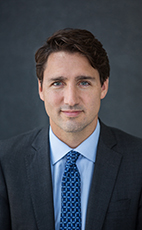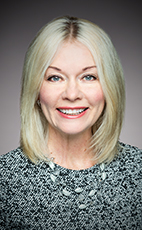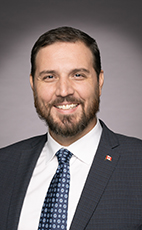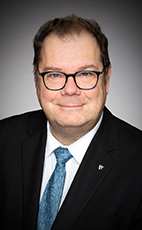44th Parl. 1st Sess.
March 1, 2022 10:00AM
- Mar/1/22 11:07:08 a.m.
- Watch
Madam Speaker, I will be sharing my time with the member for Mégantic—L'Érable.
I am pleased to be joining the debate on this motion. I would have much loved to have been there, but members can probably hear that I sound a bit ill. I have a cold, so I cannot fly there and take part in this debate in person.
I want to outline to my constituents, Albertans, westerners and Canadians how the process works. There is a Yiddish proverb, but I need to introduce how this is going to work first. The Constitution in Canada requires a redistribution of seats every 10 years. This is done based on the political weight of the various provinces. Statistics Canada produces a census. That census was released in February with the data within it.
I have two interesting data points I want to note. As an Albertan, I represent the second largest riding by population size in Canada with 163,447 people living here. Many members will know that number is 40% bigger than what the original quotient average was intended to be. My colleague for Edmonton—Wetaskiwin represents 209,431 people in his riding, which is double the number of what an average riding in Canada should have. With that comes double the case files, double the emails and double the phone calls. Essentially it is double everything with the same resources and the same person to represent them all.
That is the life of an urban Calgary MP. Edmonton—Wetaskiwin happens to be one of those rare “rurban” ridings. It is both a rural county and the city of Edmonton, which is slowly growing into the county as it builds brand new suburbs, which can seen when driving north on Highway 2. That is the challenge of an urban MP.
Then we have the challenges of rural MPs. Those ridings have perhaps fewer people in them, but they have more mayors, more city councillors, more local clubs. Members might be surprised to know that, up until very recently, I did not even have a high school in my riding. Up until 2018, I had no high school in my riding in the city of Calgary. I know that is shocking, but it is not the case for rural MPs. They may have three, four, five, six high schools depending on how big the counties are and which areas they go into. Sometimes small towns have basically everything from kindergarten all the way to grade 11 or grade 12, just in their riding. That brings its own challenges in representation.
When we do the redistribution of the Constitution every 10 years, it is based purely on demographic weight, not political weight, all across Canada. There are four rules that are followed when we do redistributions in Canada. As I said, I have a Yiddish proverb, “Don't give me the honey and spare me the sting”.
We are westerners, and both of us represent provinces which are under-represented. The honey to us would be to have more seats, and Alberta is looking at three seats in this redistribution. The sting comes with the fact that every redistribution makes lots of people unhappy. There is always the case that not everybody gets everything that they would like based on the formula.
Let us talk about the formula that was used. The formula was passed in 2011 and received royal assent in 2012. It is called the Fair Representation Act. It basically acknowledged the fact that the fastest growing provinces in Canada were not gaining enough seats to ensure representation by population. Those three provinces namely were Ontario, British Columbia and my home province of Alberta. In this redistribution, the goal was to ensure that they would catch up in effect. That is why in 2015 we saw the addition of 30 new ridings. It was to try to get closer to what is called “rep by pop” and get closer to the representation that is mandated by the Constitution.
In this redistribution, the electoral quotient being used by Elections Canada is 121,891. Of course, there will be some back and forth available here in order to ensure that the smaller towns, counties and regions are well represented and to reduce to the minimal amount possible the distance MPs have to drive to represent their constituents.
In Canada there are four rules. The first is a quotient that is used by Elections Canada to determine how many seats per riding should be available. We then apply the senatorial clause, so no province can have fewer members of Parliament than it has senators in the Senate of Canada, that other place. Then we apply the grandfathering clause. In 1985, we basically agreed that no province should lose a seat based on what it had in 1985. There are slower growing provinces. Today this primarily impacts Saskatchewan, Manitoba, Quebec, Nova Scotia, and Newfoundland and Labrador. Finally, in 2011-12, we added the representation rule specifically applied to the province of Quebec in order to ensure that it would always have representation by population.
I will note that in this redistribution, the population of Quebec, according to Statistics Canada is 22.57% and 22.71% will be the seat count. It is trying to reach that goal of getting to an apportionment representation by population in that particular situation.
We have heard some of the challenges that exist in representing very large ridings and representing urban ridings, and the overall challenge of representation as a member of Parliament. I think it is very challenging. Every single formula we agree to at any point will have winners and losers in it, and we are always trying to go for that win-win.
In preparing for this debate, I went back to the debates that happened originally in 2011 and 2012 on this particular subject of how we could ensure that we did not just keep increasing the number of MPs, as other Westminster parliaments have done, because we have these rules we have agreed to over the last 40 or 50 years. However, it is always stinging when we have these changes that can happen based on a formula.
It is hard to predict what is going to happen just a few weeks from now. It is hard to predict what will happen 10 years from now. Economics bears a great deal of weight on how population movement happens in Canada. My home province of Alberta had a boom in the early 2000s that attracted an enormous number of people to our home province, who settled there and brought their families. We built schools and highways and everything. It was a very attractive point for people to move there, so our population grew incredibly quickly.
That is the case for British Columbia today. It is still the case for Ontario. The number one destination for a lot of people who come to Canada remains our major cities, and the biggest city in Canada is Toronto and the greater Toronto region, which continues to attract so many people because of the job opportunities and the economic opportunities it provides. It is also a great place to live, work and play, which I would say all of Canada is. We are in the greatest country in the world, and we should cherish that and make sure that whatever we do here addresses those points and continues that for future generations.
In section (b) of the motion the Bloc has proposed, it does not really propose a solution. There is no real solution here for how to fix the problem the Bloc members have identified. They say “political weight”, but I would read into it as preferably “democratic weight”, and it would apply to only one province. However, the second part of the motion does not offer a formula solution, and the Electoral Boundaries Commission, which is this independent commission, is already working.
It has already started its work. It has a website we can go to. There are actually commission reports. The commission has already started its work. It is already working, so essentially what the Bloc is asking here is to change the rules of the game once the game has already started, and it would be difficult to direct the commission to change it. I think it is still pretty early in the process. I do not think it is impossible, but we should recognize that since October the commissioners have been appointed and they have been holding consultation meetings already. By August, at the latest, they are supposed to write back and publicly disclose the maps that would be used for the next redistribution, hopefully in time for the next federal election.
However, if we go to the Elections Canada's website and the electoral boundaries commission's website, it is saying these changes may not be in place until April 1, 2024. This is a minority Parliament; let us recognize that. The last time a Parliament took it upon itself to discuss this, it was the 2008 to 2011 Parliament, and it was not able to finish it then, which is why it was passed in 2012.
I wanted to lay that out. There is a good logical case to be made that no province should be made worse off after redistribution, but we have this formula, a formula that received royal assent in 2012. It is the 11th hour, so to speak, and I know it is stinging for those who believe that no province should lose a seat. We have different constitutional rules and conventions in place to ensure that does not happen.
I will be happy to take questions and to continue this debate with colleagues in the chamber.
1648 words
All Topics
- Hear!
- Rabble!
- add
- star_border
- share
- Mar/1/22 1:45:06 p.m.
- Watch
Qujannamiik, Uqaqtittiji.
I represent 25 remote fly-in communities, 25 communities with mayors, 25 communities with airports and 25 communities with any number of schools, including a French school in Iqaluit. The land mass of my riding extends from Alberta to Quebec. The discussion on seat distribution is of particular interest to me, and I realize the member thinks that the timing is not the best.
Does the member agree that the representation criteria and seat distribution should be expanded to include the vastness of the land mass in Canada?
90 words
- Hear!
- Rabble!
- add
- star_border
- share
- Mar/1/22 1:48:05 p.m.
- Watch
Mr. Speaker, I am pleased to rise today to discuss the House of Commons seat distribution formula and the redrawing of the federal electoral map.
On October 15, 2021, the Chief Electoral Officer of Canada announced the redistribution of seats in the House of Commons.
Under the current electoral boundaries readjustment process, the provinces and territories will be represented in the House of Commons as follows: 43 seats for British Columbia, 37 for Alberta, 14 for Saskatchewan, 14 for Manitoba, 122 for Ontario, 77 for Quebec, 10 for New Brunswick, 11 for Nova Scotia, 4 for Prince Edward Island, 7 for Newfoundland and Labrador, 1 for Yukon, 1 for the Northwest Territories, and 1 for Nunavut.
This distribution is the result of a calculation based on population estimates provided by the chief statistician of Canada and a formula set out in the Constitution Act, 1867.
For nearly 60 years, independent, non-partisan electoral boundary commissions have been responsible for redrawing our electoral maps. These commissions were established in 1964, when Parliament passed the Electoral Boundaries Readjustment Act. The act sets out the rules and responsibilities, the process, and the criteria these commissions must follow when redrawing our federal electoral boundaries.
This independent approach was introduced by design to reduce the risk of political interference in the process and to maintain integrity and transparency in our democratic systems and institutions. Prior to 1964, the House of Commons itself was responsible for fixing the boundaries of electoral districts through a committee appointed especially for that purpose. However, Parliament realized that the manipulation of riding boundaries to benefit members of the governing party was a significant risk to the integrity of our system. That was and remains unacceptable.
The introduction of the Electoral Boundaries Readjustment Act was a critical measure put in place to solve that problem. As outlined in the act, a three-member commission must be established for each province. These commissions are composed of one chairperson and two commissioners. I would like to remind hon. members that, because this process occurs every 10 years, the government does not recommend or appoint members to these provincial commissions. To be clear, they are independently appointed. In fact, the government's role in the entire process is extremely limited.
I would now like to talk about the formula used for redistribution. There are four steps. This is how the Chief Electoral Officer arrived at the result mentioned earlier.
First, the initial number of seats allocated to each province is calculated. To do that, the electoral quotient must be calculated, based on the average of each province's growth rate over the past decade. Quebec, for example, grew by 7.83% between 2011 and 2021. In contrast, Ontario grew by 10.87%, British Columbia by 14.03%, and Alberta by 17.56%. Together, the 10 provinces yielded an average growth rate of 9.65%.
Then the electoral quotient of the previous redistribution, which was 111,116, is multiplied by that average to get a new quotient of 121,891. Finally, the number of seats initially allocated to each province is calculated by dividing the population number of each province by the new electoral quotient.
That gives us five seats for Newfoundland and Labrador, two for Prince Edward Island, nine for Nova Scotia, seven for New Brunswick, 71 for Quebec, 122 for Ontario, 12 for Manitoba, 10 for Saskatchewan, 37 for Alberta and, finally, 43 for British Columbia, for a total of 318 seats.
It is equally important to note that it is this step that determines whether new members will be added to the House of Commons. Although the average growth rate of the provinces over the past decade was 9.65%, the growth rate of the 10 provinces combined was actually 10.90% for the same period.
When the quotient grows more slowly than Canada, there is an increase in the House. However, if the quotient increases at the same rate as the 10 provinces, there would be no change in the total number of seats. Therefore, if the quotient increases faster than the 10 provinces, there would be a reduction in the total number of seats.
That means that the location of the growth has a significant influence on the size of the House.
Getting back to the formula, following the calculation of the initial number of seats allocated to the provinces, the second step is to apply the special clauses, namely the senatorial clause and the grandfather clause. This step guarantees that the provinces have no fewer seats than they have in the Senate and no fewer than they had in 1985 in the 33rd Parliament.
This step adds two seats to Newfoundland and Labrador for a total of seven. It adds two seats to Prince Edward Island for a total of four. It adds two seats to Nova Scotia for a total of 11. It adds three seats to New Brunswick for a total of 10. It adds four seats to Quebec for a total of 75. It adds two seats to Manitoba for a total of 14. Finally, it adds four seats to Saskatchewan for a total of 14.
The third step, the representation rule, applies only to a province whose population was over-represented in the House of Commons after the last redistribution. If such a province becomes over-represented as a result of the previous calculations, it is allocated additional seats so that its share of seats in the House of Commons is proportional to its share of the population. However, it is important to note that this rule applies to the provinces, not the territories. The latter are therefore not included in the calculations.
The representation rule applies to Newfoundland and Labrador, Prince Edward Island, Nova Scotia, New Brunswick, Quebec, Manitoba and Saskatchewan. However, after the second step, Quebec is the only one of these provinces whose number of seats is proportionally smaller than its share of the population. Two seats are therefore added to Quebec, for a total of 77 seats.
At the fourth step, three seats are allocated to the territories. One to the Yukon, one to the Northwest Territories and one to Nunavut. This brings the total number of seats in the House of Commons to 342, as announced by the Chief Electoral Officer.
The formula has been amended many times over the years, most recently in 2011. It is not simply a mathematical calculation based solely on the province's population. This formula protects provinces whose populations are dropping, while still providing for provinces that experience rapid growth to get more seats. In conclusion, it is important to note that the redistribution process, which includes the new distribution of seats, is done independently and normatively to prevent any partisan influence.
1133 words
All Topics
- Hear!
- Rabble!
- add
- star_border
- share
- Mar/1/22 2:22:52 p.m.
- Watch
Mr. Speaker, as a government, we have been there for Alberta, Saskatchewan, Newfoundland and Labrador and their energy sectors. We are actually moving forward with the Trans Mountain pipeline expansion, which the Conservatives could not get approved and could not get built. We are going to continue to work to ensure that we are supporting workers in the energy industry, even as we ensure that we are moving forward in ways that reduce carbon from our atmosphere and create a better future with good jobs for everyone.
Canada has a significant role to play in the world. We will continue to play it with Europe and with other allies as well.
111 words
- Hear!
- Rabble!
- add
- star_border
- share
- Mar/1/22 2:24:44 p.m.
- Watch
Mr. Speaker, here is a lane we would like the Prime Minister to pick from. Today is March 1 and, as of today, Saskatchewan, Manitoba, Alberta, Ontario and Nova Scotia have all lifted their vaccine mandates and other provinces are following suit. Why? Because it is safe to do so and they care about mental health and their economies.
Here at the federal level, we have a Liberal government that is dragging its knuckles because it has become so backward and regressive in its thinking when it comes to the need for restrictions. When will the Liberals come out of the dark ages and see that vaccine mandates are so yesterday? When are they going to go remove the federal mandates?
121 words
- Hear!
- Rabble!
- add
- star_border
- share
- Mar/1/22 4:41:30 p.m.
- Watch
Madam Speaker, I appreciate the opportunity to ask a question. It has been interesting to hear this debate. It is a needed discussion on democratic reform in this country to ensure that our democracy is responsive to the demands of a modern nation. I come from Alberta and we are quite under-represented in this place when it comes to representation by population.
I find it very interesting that on a day when the Bloc is endeavouring to raise concerns related to Quebec and regional issues, in question period its leader and other members of the party went to great lengths to attack an industry that is well represented and that many of my constituents work in: the energy industry.
As I am listening with great interest to the speeches, can the member help me reconcile how talking about regional interests is not simply a Quebec issue, but also has a significant impact on the rest of the country?
159 words
- Hear!
- Rabble!
- add
- star_border
- share
- Mar/1/22 4:42:35 p.m.
- Watch
Madam Speaker, I thank my colleague and friend from the Conservative Party for his excellent question.
I think that the environment needs to be considered here. We are not against Alberta. We are in favour of combatting climate change, and we think we need to reduce our dependence on oil. We are prepared to help Alberta through the energy transition.
I do not think it will have a choice. If we want to secure an economic future, we ultimately cannot rely entirely on oil. That does not mean that we need to eradicate oil. We will still need it tomorrow. The issue in Quebec is a little different because we are a nation, a people, with a very different language and culture, and we want to continue to exist, much like the first nations want to continue to exist. We have nothing against the people of Alberta, despite our difference of opinion on environmental issues. I think that debate is the path to serenity.
164 words
- Hear!
- Rabble!
- add
- star_border
- share
- menumenu
- notificationsnotifications
- home
- mailmail
- searchsearch



